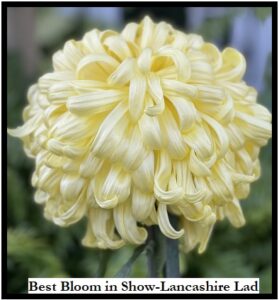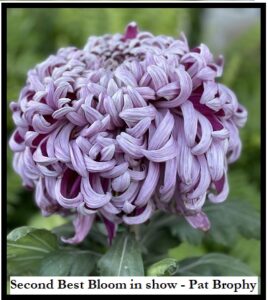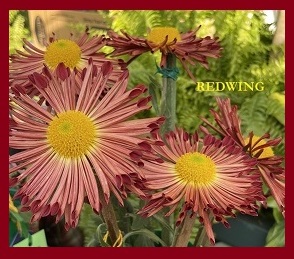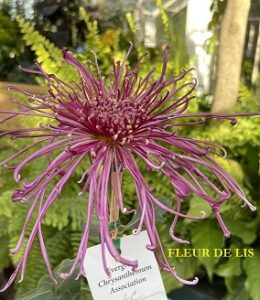OCTOBER TO DO LIST
This month the focus is on finishing the blooms, preparing them for transport to the show and the grooming and presentation of the blooms for the show.
1. Care and feeding,
-Tie cedar support stakes under the blooms to keep the stems straight and the blooms upright. A cocked bloom will be severely discounted by the judges. Keep raising the support stake up against the bottom of the bloom to prevent or correct cocking.
-Water and feed plants sparingly at this time (October time frame). Feed with liquid fertilizer solution about 1 pint at each watering. See fertilizer recommendations below. It’s a good practice to make up a 30 gallon garbage can of the fertilizer solution and set this can out in the sunlight so that it will remain relatively warm. Then water/feed out of this barrel. Note: If you use fresh tap water instead, you will be watering/feeding with a water temperature below 50 deg. That sets back the plant each time you water. Water/feed sparingly, preferably around 5:00 pm. Some prefer to water early in the day, but if you do be sure to use the warm water from the barrel.
-The recommended dilution of the fertilizer is: ½ tsp of the standard 20-9-20 midseason fertilizer plus ¼ tsp Sulphate of Potash (0-0-50) per gallon of water. That’s essentially half the usual dilution of (20-9-20) you’ve been using for mid season plus the potash is added to harden off the stems and the petals.
-Sheltering your plants is crucial. Get the plants moved into some sort of shelter where the blooms are protected from rain, dew, wind and direct sunlight. It does not have to be a totally enclosed shelter but enclosed shelters prove to be of advantage in developing near perfect blooms. The blooms do not need direct sunlight but some filtered sunlight is desirable. I have pinned white sheets under clear roof panels. This filters the sun and additionally collects dew that collects on the panels at night. If you move your plants into enclosed spaces then you must also provide lots of cool dry ventilation to protect against petal rot. Multiple fans blowing gently across the blooms is the usual solution. It’s generally desirable to keep the daytime temperatures below 75 degrees and the night time temperatures above 50 degrees during this final bloom phase.
If you move your plants into area where the sunlight is poor or non existent, then you will need considerable supplemental light as discussed in the Sept. To Do list.
-Watch for Aphids and other insects. The Marathon systemic insecticide you added in June or July should protect you very well from Aphids; but it does not catch all insects and bugs, and if you didn’t use it or used a diluted application then it’s possible you could find aphids and other insects such as earwigs in your blooms. Earwigs have to be handpicked from the blooms and other such bugs must be caught with a watchful eye before they severely damage the bloom. If the blooms are dry and out of the sunlight it is possible to spray the bloom with a very fine solution of liquid insecticide such as diazinon or other mild insecticides. Generally you will need to spray every 4-5 days apart for 3 or 4 applications. This could in some cases destroy your blooms; but then so would the Aphids. If aphids are in the blooms at the show it will be downgraded, or if badly infested the bloom will be removed from the show.
You need to keep your blooms clean during the bloom development so when damaged petals or rot marred petals are found you should remove them so as not to propagate the problem. Generally speaking you can, with dry fingers, take hold of the petal end and gradually pull and swirl the petal around. This will generally loosen the root and the petal will come out. Sometimes you need to use tweezers to get the petal. Homemade wooden tweezers are preferred.
2. Getting ready for the show:
-As show time approaches you may be able to speed up bloom development with supplemental heat; i.e. electric heaters in the finishing areas. Again the suggested minimum heat in the area is 50 deg. But with supplemental heat you might approach 60 deg. minimum. Also some varieties don’t particularly like too much heat. An old adage generalizes this: Reflexes like light, Incurves like heat, so it takes a lot of judgment and experimenting to tinker with the climate you have.
Likewise if a bloom is developing too early it may be possible to slow the development by placing the plant in a cooler darker area; i.e. a basement. Of course not all varieties respond well to that treatment either and in some cases you might end up stalling the plant out completely.
-Cutting the blooms for the show: Water the plants the night before cutting- start cutting early in the morning. That’s when the stem cells contain the most water
-Cut the stem approximately 20 inches below the bottom of the bud, keeping the bloom support stake attached to the stem. -Cut at a slant and immediately put the stem in a bucket of water. (Lower leaves on the stem should have been removed leaving 3- 5 leaves at the base of the bloom). Then recut the stem approximately 1 inch above the previous cut while under water. This removes air bubbles that cling to the end of the stem and impede water uptake. Let the cut stem remain in the water for a few seconds, and then remove to a vase or water bucket for transportation to the show.
-Cut the incurves 3-4 days before judging day. The centers will develop much faster in a vase or bucket of mildly warm water (100 deg for example) than they will on the plant. Most others I cut 1-2 days before judging. Following these procedures the cut bloom will hold up well for 1-2 weeks. The key is the second cutting under water.
-When you do the final arrangement of your bloom(s) you should make the final cut. Our show rules state that cutting most blooms 16 inches below the bud bottom is desired (That’s the length of the support stake you cut from 16 inch shingles. However the rules allow for up to 18 inch stems and supports for the very large blooms so that the lower petals don’t reach the vase. This also helps where the upper leaves are far below the bloom base and sometimes get shoved into the top of the vase.
Where multiple blooms are required in entry, you should work at cutting the stems slightly below the support so that the stems can be individually trimmed to present the top of each bloom at the same height. Please don’t get carried away and cut your blooms higher, making them more noticeable than comparable entries. The Judges can penalize you for such practices.
-In multiple bloom entries of 3 or 5 blooms per vase, variations to the same height rule are allowed/ preferred such that the back blooms are somewhat higher than the forward blooms.




